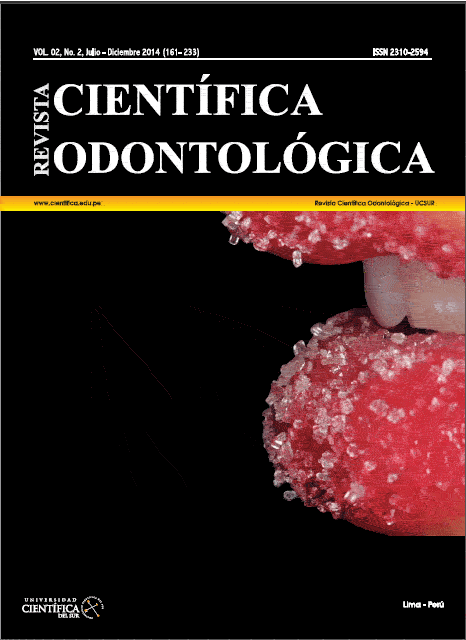Evaluación de la arteria alveolar superior posterior durante el levantamiento del seno maxilar con uso de la tomografía computarizada como diagnóstico
DOI:
https://doi.org/10.21142/2523-2754-0202-2014-%25pKeywords:
Tomografía Computarizada por Rayos X, Seno Maxilar, Arteria Alveolar,Abstract
La implantología oral, ha evolucionado mucho en los últimos años, brindando a los dentistas y a los pacientes, más
opciones de tratamiento dependiendo de cada caso; como es el caso de pacientes parcialmente desdentados con insuficiente
hueso para colocarse implantes en la zona postero superior precediendo a una elevación del seno maxilar. Es
importante conocer y evaluar la anatomía del seno maxilar antes de su elevación, para evitar complicaciones quirúrgicas.
La arteria alveolar posterior superior (AAPS) es una rama de la arteria maxilar que suministra irrigación a la pared lateral
del seno y subyacente a la membrana. El uso de la tomografía computarizada (CT) cumple un rol muy importante
en el diagnóstico de patología sinusal, septum y ubicación de la AAPS y como plan de tratamiento. El siguiente artículo
presenta un caso clínico que localiza la AAPS durante el levantamiento de seno maxilar.
Downloads
References
Elian N, Wallace S, Cho S-C, Jalbout ZN, Froum S. Distribution of the maxillary artery as it relates to sinus floor augmentation. Int J Oral Maxillofac Implants. 2005;20(5):784-7.
Jensen OT, Shulman LB, Block MS, Iacono VJ. Report of the Sinus Consensus Conference of 1996. Int J Oral Maxillofac Implants. 1998;13 Suppl:11-45.
Boyne PJ, James RA. Grafting of the maxillary sinus floor with autogenous marrow and bone. J Oral Surg Am Dent Assoc 1965. 1980;38(8):613-6.
Summers RB. The osteotome technique: Part 3--Less invasive methods of elevating the sinus floor. Compend Newtown Pa. 1994;15(6):698, 700, 702-4 passim; quiz 710.
Fugazzotto PA. Sinus floor augmentation at the time of maxillary molar extraction: technique and report of preliminary results. Int J Oral Maxillofac Implants. 1999;14(4):536-42.
Wood RM, Moore DL. Grafting of the maxillary sinus with intraorally harvested autogenous bone prior to implant placement. Int J Oral Maxillofac Implants. 988;3(3):209-14.
Smiler DG. The sinus lift graft: basic technique and variations. Pract Periodontics Aesthetic Dent PPAD. 1997;9(8):885-93; quiz 895.
Tong DC, Rioux K, Drangsholt M, Beirne OR. A review of survival rates for implants placed in grafted maxillary sinuses using meta-analysis. Int J Oral Maxillofac Implants. 1998;13(2):175-82.
Traxler H, Windisch A, Geyerhofer U, Surd R, Solar P, Firbas W. Arterial blood supply of the maxillary sinus. Clin Anat N Y N. 1999;12(6):417-21.
Solar P, Geyerhofer U, Traxler H, Windisch A, Ulm C, Watzek G. Blood supply to the maxillary sinus relevant to sinus floor elevation procedures. Clin Oral Implants Res. 1999;10(1):34-44.
Hur M-S, Kim J-K, Hu K-S, Bae HEK, Park H-S, Kim H-J. Clinical implications of the topography and distribution of the posterior superior alveolar artery. J Craniofac Surg. 2009;20(2):551-4.
Ella B, Sédarat C, Noble RDC, Normand E, Lauverjat Y, Siberchicot F, et al. Vascular connections of the lateral wall of the sinus: surgical effect in sinus augmentation. Int J Oral Maxillofac Implants. 2008;23(6):1047-52.
Tatum H. Maxillary and sinus implant reconstructions. Dent Clin North Am.1986;30(2):207-29.
Regev E, Smith RA, Perrott DH, Pogrel MA. Maxillary sinus complications related to endosseous implants. Int J Oral Maxillofac Implants. 1995;10(4):451-61.
Shibli JA, Faveri M, Ferrari DS, Melo L, Garcia RV, d’ Avila S, et al. Prevalence of maxillary sinus septa in 1024 subjects with edentulous upper jaws: a retrospective study. J Oral Implantol. 2007;33(5):293-6.
Krennmair G, Ulm C, Lugmayr H. Maxillary sinus septa: incidence, morphology and clinical implications. J Cranio-Maxillo-fac Surg Off Publ Eur Assoc Cranio-Maxillo-fac Surg.1997;25(5):261-5.
Krennmair G, Ulm CW, Lugmayr H, Solar P. The incidence, location, and height of maxillary sinus septa in the edentulous and dentate maxilla. J Oral Maxillofac Surg Off J Am Assoc Oral Maxillofac
Surg.1999;57(6):667-71; discussion 671-2.
Gosau M, Rink D, Driemel O, Draenert FG. Maxillary sinus anatomy: a cadaveric study with clinical implications. Anat Rec Hoboken NJ 2007;292(3):352-4..
Flanagan D. Arterial supply of maxillary sinus and potential for bleeding complication during lateral approach sinus elevation. Implant Dent. 2005;14(4):336-8.
Chanavaz M. Sinus grafting related to implantology. Statistical analysis of 15 years of surgical experience (1979-1994). J Oral Implantol. 1996;22(2):119-30.
Marx RE, Garg AK. A novel aid to elevation of the sinus membrane for the sinus lift procedure. Implant Dent. 2002;11(3):268-71.
Güncü GN, Yildirim YD, Wang H-L, Tözüm TF. Location of posterior superior alveolar artery and evaluation of maxillary sinus anatomy with computerized tomography: a clinical study. Clin Oral Implants
Res.2011;22(10):1164-7.
Mardinger O, Abba M, Hirshberg A, Schwartz-Arad D. Prevalence, diameter and course of the maxillary intraosseous vascular canal with relation to sinus augmentation procedure: a radiographic study. Int J Oral Maxillofac Surg. 2007;36(8):735-8.
Downloads
Published
Issue
Section
License

Este obra está bajo una licencia de Creative Commons Reconocimiento 4.0 Internacional.












